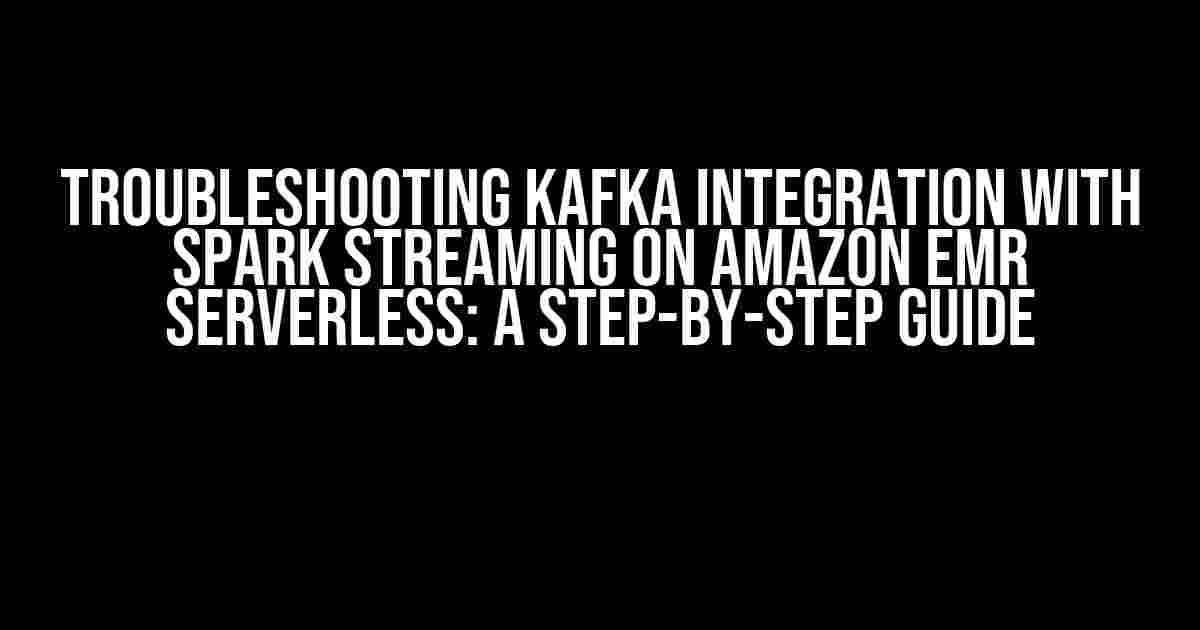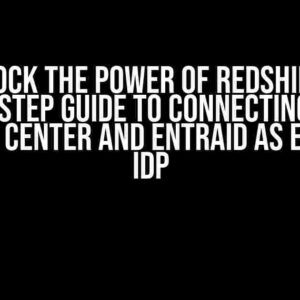Are you tired of dealing with pesky errors and issues when integrating Kafka with Spark Streaming on Amazon EMR Serverless? Look no further! In this article, we’ll take you on a journey to troubleshoot and resolve the most common problems that arise during this integration. Buckle up, and let’s dive in!
Prerequisites
Before we begin, make sure you have the following prerequisites in place:
- A working Amazon EMR Serverless cluster with Spark 2.x or 3.x
- Kafka cluster with topics created and data being produced
- Spark Streaming application code written in Scala or Python
- A basic understanding of Kafka, Spark, and EMR Serverless
Common Issues and Errors
Let’s jump right into the most common issues and errors you might encounter when integrating Kafka with Spark Streaming on Amazon EMR Serverless:
Kafka Connection Issues
KafkaConfig boz0: Failed to connect to kafka server: {kafka-broker1:9092}
This error occurs when Spark can’t connect to the Kafka broker. To resolve this:
- Check the Kafka broker’s hostname and port in the Spark configuration
- Verify the Kafka cluster is up and running
- Ensure the security group allows Spark to connect to Kafka
- Check the Kafka topic exists and has data being produced
Data Serialization Issues
java.lang.ClassNotFoundException: kafka.serializer.StringDecoder
This error occurs when Spark can’t find the required serializer class. To resolve this:
- Check the Kafka dependency version in the Spark configuration
- Verify the Kafka version is compatible with the Spark version
- Include the required serializer class in the Spark application code
Kafka Offset Issues
org.apache.kafka.clients.consumer.OffsetOutOfRangeException
This error occurs when Spark can’t find the Kafka offset. To resolve this:
- Check the Kafka topic’s retention period and offset reset strategy
- Verify the Spark application is correctly configured to read from Kafka
- Check the Kafka consumer group ID and ensure it’s unique
Troubleshooting Tools and Techniques
Now that we’ve covered some common issues, let’s explore some troubleshooting tools and techniques to help you debug and resolve problems:
Kafka Console Consumer
Use the Kafka Console Consumer to test Kafka topic data and verify offset issues:
kafka-console-consumer.sh --bootstrap-server kafka-broker1:9092 --topic my-topic --from-beginning
Spark UI and Debugging
Use the Spark UI to debug Spark Streaming applications and identify issues:
Access the Spark UI by navigating to http://spark-master:4040 and exploring the following tabs:
- Streaming tab: Monitor streaming data and identify issues
- Executors tab: Check executor logs and identify errors
- Jobs tab: Analyze job execution and identify failures
EMR Serverless Logs
Use EMR Serverless logs to identify issues with the Spark application and Kafka integration:
Access EMR Serverless logs by navigating to the AWS Management Console and following these steps:
- Navigate to the EMR dashboard and select your cluster
- Click on the “Application logs” tab
- Filter logs by application ID and Spark driver logs
- Analyze logs to identify errors and issues
Best Practices for Kafka Integration with Spark Streaming on Amazon EMR Serverless
To avoid common issues and ensure a smooth integration, follow these best practices:
| Best Practice | Description |
|---|---|
| Use compatible Kafka and Spark versions | Ensure the Kafka version is compatible with the Spark version to avoid serialization issues |
| Configure Spark correctly | Verify the Spark configuration for Kafka integration, including bootstrap servers, topic names, and serializer classes |
| Monitor Kafka topic data and offsets | Regularly monitor Kafka topic data and offsets to identify issues and debug problems |
| Use EMR Serverless logging and monitoring | Use EMR Serverless logs and monitoring tools to identify issues and debug problems |
| Test and validate Kafka integration | Test and validate Kafka integration with Spark Streaming to ensure data is being processed correctly |
Conclusion
Troubleshooting Kafka integration with Spark Streaming on Amazon EMR Serverless can be a complex task, but by following the steps and best practices outlined in this article, you’ll be well-equipped to resolve common issues and ensure a smooth integration. Remember to stay calm, think methodically, and use the troubleshooting tools and techniques to identify and fix problems. Happy troubleshooting!
Do you have any questions or need further assistance? Leave a comment below, and we’ll be happy to help!
Frequently Asked Questions
Get answers to the most pressing questions about troubleshooting Kafka integration with Spark Streaming on Amazon EMR Serverless.
Why is my Kafka topic not receiving data in EMR Serverless?
One common reason for this issue is incorrect configuration of the Kafka bootstrap server or incorrect Topic Name. Double-check your Kafka configuration and ensure that the bootstrap server URL and Topic Name match the ones specified in your Kafka cluster. Also, verify that the Kafka cluster is up and running, and the topic is properly created.
How do I troubleshoot Kafka connection issues in EMR Serverless?
To troubleshoot Kafka connection issues, check the EMR Serverless logs for any error messages related to Kafka connections. Also, verify that the Kafka security group allows incoming traffic from the EMR Serverless cluster. You can also try to connect to the Kafka cluster using the Kafka console consumer or producer tool to isolate the issue.
Why is my Spark Streaming application not consuming data from Kafka in EMR Serverless?
One possible reason is that the Spark Streaming application is not properly configured to consume from Kafka. Check that the Kafka dependency is included in the Spark application, and the Kafka configuration is correct. Also, verify that the Spark Streaming application is properly submitting to the EMR Serverless cluster. You can check the Spark UI to see if the application is running and consuming data from Kafka.
How do I optimize Kafka integration with Spark Streaming in EMR Serverless for performance?
To optimize Kafka integration with Spark Streaming in EMR Serverless for performance, consider increasing the number of partitions in the Kafka topic, increasing the Spark Streaming batch interval, and tuning the Spark configuration for better parallelism. You can also consider using the Kafka direct streaming approach instead of the receiver-based approach for better performance.
What are some best practices for monitoring Kafka integration with Spark Streaming in EMR Serverless?
Some best practices for monitoring Kafka integration with Spark Streaming in EMR Serverless include monitoring Kafka topic lag, checking Spark Streaming application metrics, and monitoring EMR Serverless cluster metrics. You can use tools like Kafka’s built-in metrics, Spark’s UI, and EMR Serverless’s CloudWatch metrics to monitor the integration.



